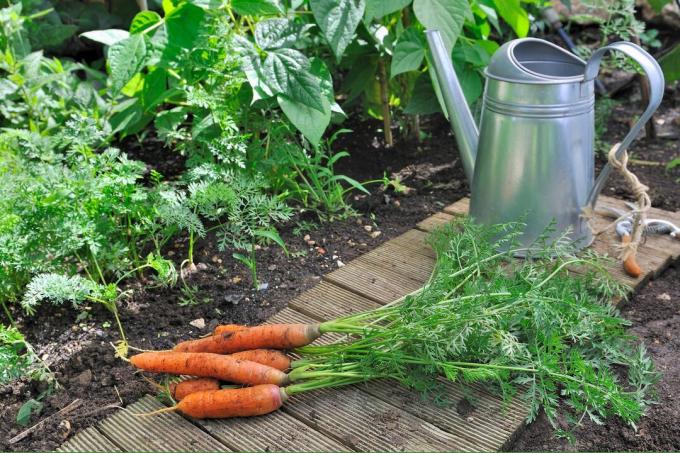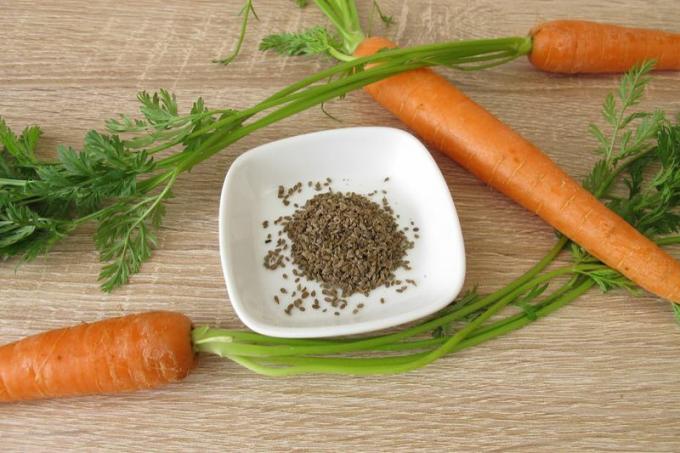
Carrots, also known as carrots, are a tasty root vegetable that you can sow very well in your own garden. The plants have a few special requirements that can be met.
In a nutshell
- possible from mid/end of April to August; in the cold frame from the beginning of March; every four weeks
- full sun to partial shade; loose, weed-free soil, enriched with some compost
- Mix seeds with quartz sand or use pelleted seeds or seed tapes
- Sowing depth 2 cm, row spacing 30 cm, press down lightly and water
- keep moist until germination; after germination, thin out to a distance of 5 cm
Table of contents
- sowing time
- Location
- Floor
- seed
- Carrot sowing instructions
- frequently asked Questions
sowing time
carrots are not preferred indoors as their long taproots make transplanting difficult. In any case, carrots grow quickly, so late direct sowing has hardly any disadvantages. If you want to harvest carrots early, you can already remove the seeds at the beginning of March sow in a cold frame. Carrots can be sown in a normal garden bed from mid/late April. Early varieties are sown first, while storage varieties are planted later, around mid-July. If you want to harvest fresh carrots regularly over the summer, you should sow new seeds every four weeks.

Location
Carrots love warmth and sunlight and also like to be outdoors raised bed. However, when sowing carrots in a very sunny location, you should keep in mind that they will need to be watered frequently and regularly. Crop rotation must be taken into account when selecting the sowing site. The tubers only remain healthy if carrots root again at a location about three years apart.
Floor
Above all, carrots need loose soil so that the orange roots can grow unhindered and deep. If the soil is compacted, the roots remain short and often grow severely deformed. However, compacted soil can be loosened up with sand, which also prevents harmful waterlogging. Because carrots so-called medium eater are, the soil must contain some nutrients or be enriched with them before sowing.

seed
The seeds can be bought commercially or you can harvest your own plants. It is very fine and therefore difficult to sow evenly. It also tends to stick to wet hands. Mix it with quartz sand to solve this problem. Pelleted seeds are also commercially available, as well as whole seed tapes made of cellulose, in which the carrot seeds are integrated at regular intervals. They are easy to use, but more expensive than loose seeds.

Carrot sowing instructions
- Prepare the bed well. Rake the soil thoroughly until you get a finely crumbly seedbed.
- Remove larger stones and all weeds.
- If the soil is poor, spread 2-3 liters of mature compost per square meter of area, which you then work thoroughly and flatly into the soil with a rake.
- Stretch a plant string to get straight rows. These should be about 30 cm apart.
- Along the plant cord, pull a ca. 2 cm deep seed furrow. If you are using a seed tape, the groove should be wide enough for the tape to fit in without kinking.
- Roll out the seed tape smoothly. If necessary, fix it in between with a few clods of earth. Place seed pellets one at a time, 5cm apart. Try to sow loose seeds evenly.
- Always moisten laid seed tapes so that they get good contact with the ground. Use the watering can or an atomizer for this.
- Cover the seed with soil about 2 cm deep.
- Compact the soil by pressing it down firmly with your hand or with the back of a rake.
- Finally, water thoroughly with the watering can to close the last cavities.

frequently asked Questions
Carrots should develop a thick, long and beautifully shaped root. This is hardly possible on heavy soil. Therefore, loose dams of sandy soil are piled up and the seeds are sown on them. However, this type of cultivation requires more maintenance because the soil tends to dry out more quickly. Since carrots need constant, even moisture, they have to be watered often in summer.
After you have thoroughly loosened the soil, you should only enter the bed with the help of a wooden board. The body weight then not only rests on the small area under your feet, but is distributed over the board.
Carrot seeds have a long germination period. Depending on the weather, it can take up to three weeks for the seeds to sprout. Along with carrot seeds, sow a few as well radish as a marker seed. They germinate after just a few days and show where the carrots are sown. If the carrots need more space, they have long since been harvested.
There should ideally be a distance of about 5 cm between two carrot plants. As soon as the young plants show up, simply thin them out.



